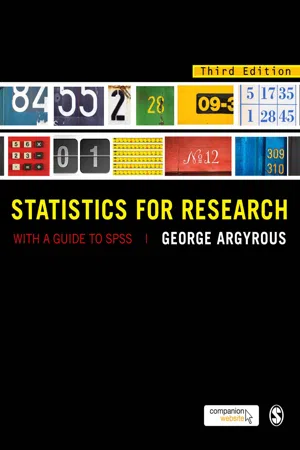
- 608 pages
- English
- ePUB (mobile friendly)
- Available on iOS & Android
About this book
This fully updated edition of Statistics for Research explains statistical concepts in a straight-forward and accessible way using practical examples from a variety of disciplines. If you?re looking for an easy-to-read, comprehensive introduction to statistics with a guide to SPSS, this is the book for you!
The new edition features:
- Clear explanations of all the main techniques of statistical analysis
- A brand new student-friendly, easy-to-navigate design
- Even more step-by-step screenshots of SPSS commands and outputs
- An extensive glossary of terms, ideal for those new to statistics
- End of chapter exercises to help you put your learning into practice
- A new, fully updated companion website (www.uk.sagepub.com/argyrous3) with comprehensive student and lecturer resources including additional, discipline specific examples and online readings and WebCT/Blackboard quizzes.
This is the ideal textbook for any course in statistical methods across the health and social sciences and a perfect starter book for students, researchers and professionals alike.
Frequently asked questions
- Essential is ideal for learners and professionals who enjoy exploring a wide range of subjects. Access the Essential Library with 800,000+ trusted titles and best-sellers across business, personal growth, and the humanities. Includes unlimited reading time and Standard Read Aloud voice.
- Complete: Perfect for advanced learners and researchers needing full, unrestricted access. Unlock 1.4M+ books across hundreds of subjects, including academic and specialized titles. The Complete Plan also includes advanced features like Premium Read Aloud and Research Assistant.
Please note we cannot support devices running on iOS 13 and Android 7 or earlier. Learn more about using the app.
Information
PART 1
An introduction to statistical analysis
ONE
Variables and their measurement
Learning objectives
- identify the cases of interest to a research study
- identify the variables of interest to a research study
- understand the issues involved in conceptualizing and operationalizing a variable
- understand the difference between nominal, ordinal, and interval/ratio levels of measurement
- identify the dependent and independent variables in a theoretical model
- know the different classes of statistical techniques
‘Is there a relationship between the health status of the students in my statistics class and their sex?’
‘Is any relationship between the health status and the sex of students in my statistics class affected by the age of the students?’
The conceptualization and operationalization of variables
- Theoretical framework. Theories are ways of interpreting the world and reconciling ourselves to it, and even though we may take for granted that a variable is worthy of research, it is in fact often a highly charged selection process that directs one’s attention to it. We may be working within an established theoretical tradition that considers certain variables to be central to its world-view. For example, Marxists consider ‘economic class’ to be a variable worthy of research, whereas another theoretical perspective might consider this variable to be uninteresting. Analysing the world in terms of economic class means not analysing it in other ways, such as social groups. This is neither good nor bad: without a theory to order our perception of the world, research will often become a jumble of observations that do not tie together in a meaningful way. We should, though, acknowledge the theoretical preconceptions upon which our choice of variables is based.
- Pre-specified research agenda. Sometimes the research question, and thereby the variables to be investigated, is not determined by the person analysing the data. For example, a consultant may contract to undertake research that has terms of reference set in advance by the contracting body. In such a situation the person or people actually doing the research might have no choice over the variables to be investigated and how they are to be defined, since they are doing work for someone else.
- Curiosity-driven research. Sometimes we might not have a clearly defined theoretical framework to operate in, nor clear directives from another person or body as to the key concepts to be investigated. Instead we want to investigate a variable purely on the basis of a hunch: a loosely conceived feeling that something useful or important might be revealed if we study a particular variable. This can be as important a reason for undertaking research as theoretical imperatives. Indeed, when moving into a whole new area of research, into which existing theories have not ventured, simple hunches can be fruitful motivations.
Table of contents
- Cover Page
- About the Author
- Title
- Copyright
- Dedication
- Table of Contents
- Extended Contents
- Preface
- Part 1 An introduction to statistical analysis
- Part 2 Descriptive statistics: Graphs and tables
- Part 3 Descriptive statistics: Numerical measures
- Part 4 Inferential statistics: Tests for a mean
- Part 5 Inferential statistics: Tests for frequency distributions
- Part 6 Inferential statistics: Other tests of significance
- Part 7 Advanced topics
- Appendix
- Key equations
- Glossary
- Answers
- Index